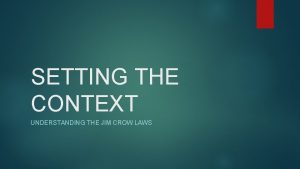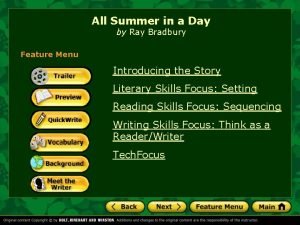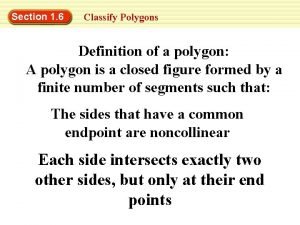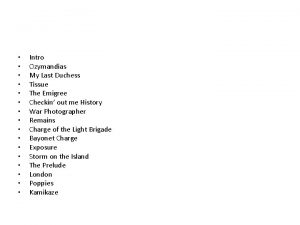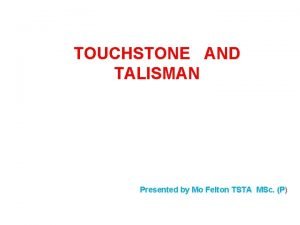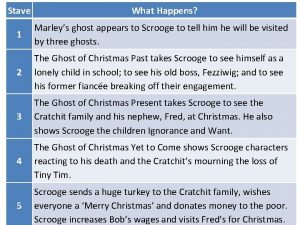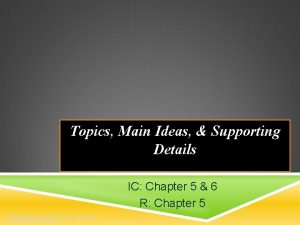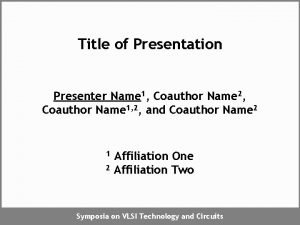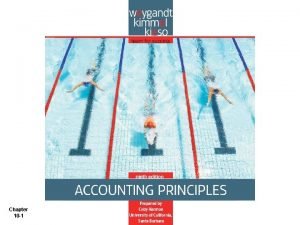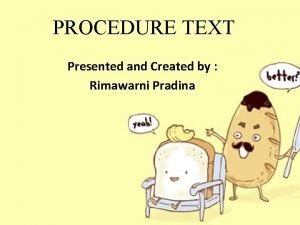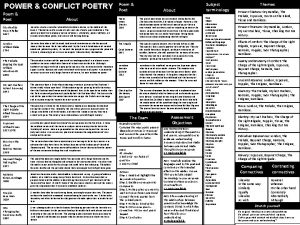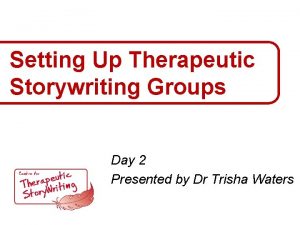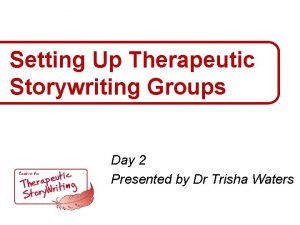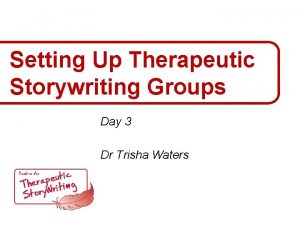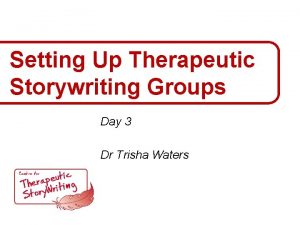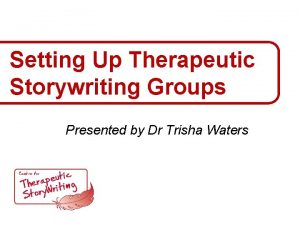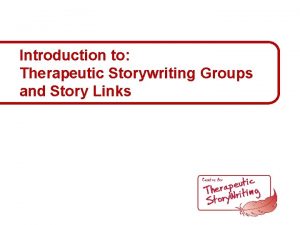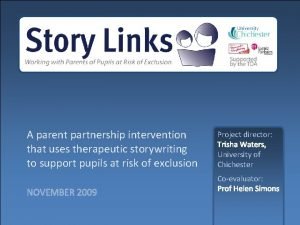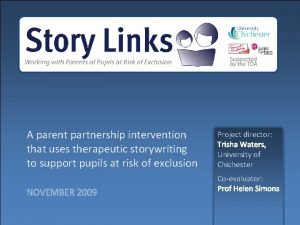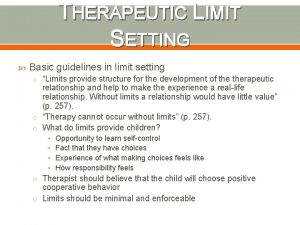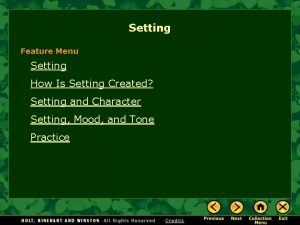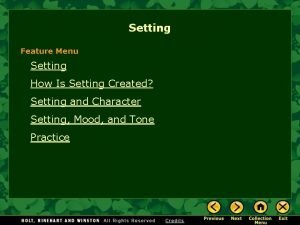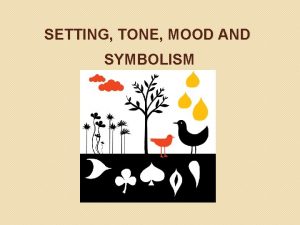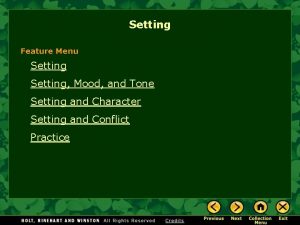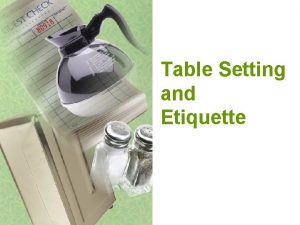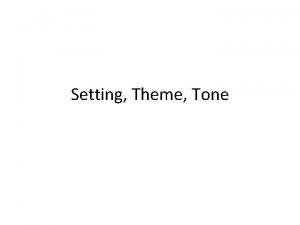Setting Up Therapeutic Storywriting Groups Day 2 Presented


































- Slides: 34

Setting Up Therapeutic Storywriting Groups Day 2 Presented by

Therapeutic Storywriting: Day 2 9. 30 -10. 50: Mindfulness, check-in & feedback from groups Feelings ladder Introduction to subpersonalities 10. 50 -11. 10: Coffee 11. 10 -1. 00: Working with subpersonalities in story writing 1. 00 -1. 45: Lunch 1. 45 -3. 30: Mindfulness exercise Containment of anxiety to facilitate thinking Active Listening and reflection of children’s stories Discussion of points arising from groups

Book references for Day 2 Waters, T (2004) Therapeutic Storywriting, London: David Fulton l Chapter 3: Subpersonalities and a Model of the Self l Chapter 7: Receiving the Child’s Story

Mindfulness Tuning

Check-in and feedback from groups l Name l Feelings l How is your group going?

Feelings ladder l Order feelings from ‘most comfortable’ to ‘least comfortable’ l Discuss l Avoid as a group the order judgemental references such as ‘positive’/‘negative’, good/bad

What are Subpersonalities? l Different discrete aspects of the self l Often have different needs and compete for attention l Each has a unique set of attributes l Unconscious subpersonalities cause problems

Working with Subpersonalities l The Self as Psychological Conductor has qualities of Awareness l Will l l Every subpersonality serves a purpose l Working with subpersonalities through: l Recognition l Identifying with l Integration l Disidentification

Exercise: Identifying Subpersonalities 10 questions

Exercise: Who Are You? l l l Group uses their answers to the 10 questions Work in pairs Partner asks: “How did your response to the question change? ” Choose one subpersonality from your list and your partner asks: “What is your name? ” “When are you present? ” “What is your job? ” “What is your body posture” “How do you feel? ” “What do you want? ” “What else do you need? ” Reverse roles Repeat choosing a different subpersonality

Case Study: Nathaniel

Nathaniel’s Picture

Drawing to deepen the metaphor l Ensure pupils have an A 4 sheet of plain paper for their illustration l Provide colour pencils but not rubbers and rulers l What do you notice about the picture? Which character is central? l Where is the energy focused? l How does the pupil use the drawing space? l How are they using colour? l

Written comments 1: Open questions focusing on a significant subpersonality character l Read through your child’s story and look at their picture l Find a character that may represent a significant subpersonality l Write down 4 or 5 open questions you might ask the child about this character?

From week 2 onwards l. Place new feeling words on the ladder l. Print out copies of one pupil’s story from last week and pupil reads it aloud to group. l. Each week teacher brings a new story opener l. Children choose to : take up the teacher’s suggestion or carry on with their current story

Exercise: Leading Mindfulness l Guide your partner to focus on: l sound in and outside the room l sensation in body beginning with feet l emotions experienced today l a word that best describes how they’re feeling at the moment l Partner gives feedback on : l Tone of voice l Pace l Emotional safety

Bion: Containment of anxiety l Anxiety contained for thinking to take place l Containment by significant other l Empathic verbal reflection l Social, Emotional & Mental Health Difficulties correlation with Speech & Language Difficulties

Active Listening is … l Focused listening l Non judgemental l Use of reflection, paraphrasing and summarising l Checking understanding l Use of non-verbal signs e. g. nodding

Active listening is not … l Having l Giving a conversation advice l Problem-solving l Saying ‘Oh I know exactly how you feel, that happened to me’ – even if it has!

Reflection and paraphrasing l Reflection repeats what has actually been said l Paraphrasing restates using your own words l Used for both content and feelings © 2014 Centre for Therapeutic Storywriting Ltd.

Content vs Feelings l Content is the actual topic that the person is describing – reflection/paraphrase is useful if there is a lack of coherence l Feelings, both those explicitly or implicitly communicated, are acknowledged using reflection or paraphrase

Summarising l Draws together main points in a few statements l Helps clarify what has been said © 2014 Centre for Therapeutic Storywriting Ltd.

Active listening exercise l l l Work in 3 s –speaker, listener & observer Speaker talks about what they did yesterday. For the first 2 min listener reflects and mirrors the content. For the second 4 min listener reflects the feelings expressed. Begin response with one of the following tentative openers: I imagine you feel… You seem to be feeling… Perhaps you might be feeling. . . It sounds as if you are feeling… Summarise in no more than 2 sentences what has been said in the last 6 min Observer keeps time and facilitates brief feedback from listener, speaker and then themselves at end of session

Active Listening in Story · Reflecting/paraphrasing story theme or plot · Reflection of feelings of characters · Summarising story so far

Summarising l Draws together main points in a few statements l Can be used for part or all of the story l Helps child link with last session l Helps clarify the plot for the child

Active Listening: Reflection of story content and feelings l Work in pairs on a pupil’s story Read story through twice pausing after every couple of sentences First use paraphrase to reflect content of story – focus on events Secondly, reflect feelings using the tentative openings Summarise story in no more than 2 sentences l Reverse roles using another pupil’s story l l

Tentative Openers Use one of the following to reflect the feelings of characters in pupils’ stories: I imagine he/she feels… He/she seems to be feeling… Perhaps he/she might be feeling. . . It sounds as if he/she is feeling…

Written Comments 2: Reflective (active listening) statements Using your child’s story write down 3 or 4 reflective (active listening) statements that focus on the feelings of the central character making sure to begin with one of the following tentative openers: I imagine he/she feels… He/She seems to be feeling… Perhaps he/she might be feeling. . . It sounds as if he/she is feeling…

Encouraging constructive feedback from the group l Self esteem = success (measured against peers) aspiration l Encourage pupils to say one thing they liked and possibly one thing that could be improved

Plenary: Receiving the Child’s Story · Open questions to identify a significant subpersonality character · Reflective ‘active listening’ statements · Encouraging constructive criticism from the group · Giving copies of one pupil’s story to the group for extra discussion each week · Typing out stories & making final published book

Exercise: Story Openers revision l Write a story opening using an animal character which names a feeling that may be uncomfortable for pupils in your group: l Name the animal character l Describe the setting l Name the feeling NB Do not say why the character is feeling like this. Use no more than two sentences.

Next Session l Identifying story themes Written emotional literacy comments Metaphor set in fantasy or external reality Addressing the ending Assessment and referring on Structure of a therapeutic story l N. B. Bring children’s stories to work with l l l

Final Comment One word or short phrase to describe how you are feeling at the end of Day 2

Further information, research & resources Centre for Therapeutic Storywriting: www. therapeuticstorywriting. com Online training manual: www. therapeuticstorywritingtraining. co. uk
 Day 1 day 2 day 3 day 4
Day 1 day 2 day 3 day 4 Setting of dr. jekyll and mr. hyde
Setting of dr. jekyll and mr. hyde Day 1 day 2 day 817
Day 1 day 2 day 817 How are ethnic groups and religious groups related
How are ethnic groups and religious groups related Understanding jim crow (setting the setting)
Understanding jim crow (setting the setting) Doing goal setting on the last day before gspeed freezes
Doing goal setting on the last day before gspeed freezes Half a day by naguib mahfouz characters
Half a day by naguib mahfouz characters Setting of all summer in a day
Setting of all summer in a day Jerome bruner cognitive theory
Jerome bruner cognitive theory Presented sy
Presented sy مقدمة عن الرسم الفني
مقدمة عن الرسم الفني Technological design steps
Technological design steps The element of music that organizes movement in time is:
The element of music that organizes movement in time is: Which fact is mentioned in both passages
Which fact is mentioned in both passages Identify the following polygons
Identify the following polygons Ozymandias and my last duchess comparison
Ozymandias and my last duchess comparison Talisman presented
Talisman presented The kitchen presented by
The kitchen presented by Kicker headline example
Kicker headline example Macbeth act 1 scene 4
Macbeth act 1 scene 4 How are the events in the text presented
How are the events in the text presented How is marley's ghost presented in stave 1
How is marley's ghost presented in stave 1 How it's made presented by
How it's made presented by Presenter title
Presenter title Co presented by
Co presented by Prism is presented with
Prism is presented with Topics presented in chapters
Topics presented in chapters Professionally presented
Professionally presented Proudly supported by
Proudly supported by Presented by name
Presented by name Depletion journal entry
Depletion journal entry How is the text presented
How is the text presented Plant assets natural resources and intangible assets中文
Plant assets natural resources and intangible assets中文 Ozymandias narrator
Ozymandias narrator Benjamin zephaniah young and dyslexic
Benjamin zephaniah young and dyslexic




